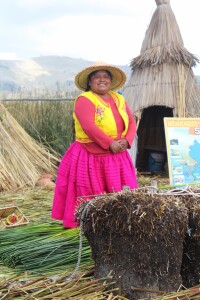Quick trip to Uros, Peru and Taquile Island
Before checking out of Lake Titicaca, had to make a quick trip out to see the floating islands and the indigenous people living there. There are approximately 80ish man-made islands on Lake Titicaca that are used by the Uros people as a floating home. Their homes, the island, and even their boats are made from a plant called, ’totora’. This plant provides everything they need to build and maintain their homes.
This all began before 1200AD, before the first Inca’s arrived in Peru. The Uros believed that their floating islands would be a good deterrent from enemy attacks. If an enemy attacked their floating village, they would simply move it to a new location. This became really important once the Incas arrived in the area.
The Incas and Uros did not get along. Almost immediately there was conflict and wars between the two nations. The Uros made good on their strategy and moved their islands out of reach of the Incas. Now, I’m sure there were still some conflicts that occurred, but by and large the Incas left the Uros be and concentrated on the mainland peoples. Besides, it wasn’t long before the Spanish arrived and the Incas had their hands full fighting them.

President of San Pedro island. The presidency rotates each year to a new family, but is always a woman.
 To build one of these floating islands takes a lot of work and ingenuity. First blocks of roots from the totora plant are harvested by cutting them into blocks and tying them together to form a base layer. Once they are secured together, layers of interlocking reeds from the totora plant are laid on top of the root blocks. It takes as many as 6 to 8 layers to build a good island.
To build one of these floating islands takes a lot of work and ingenuity. First blocks of roots from the totora plant are harvested by cutting them into blocks and tying them together to form a base layer. Once they are secured together, layers of interlocking reeds from the totora plant are laid on top of the root blocks. It takes as many as 6 to 8 layers to build a good island.
 Once the basic island is complete, homes made from the same plant are constructed on top of the island. These are very simple structures; most consist of only 1 room. These islands will last about 30 years if cared for properly. Every month a new layer of reeds must be placed on top of the old ones to keep the island afloat. This means that their homes must be raised and moved in order to place new reeds under them.
Once the basic island is complete, homes made from the same plant are constructed on top of the island. These are very simple structures; most consist of only 1 room. These islands will last about 30 years if cared for properly. Every month a new layer of reeds must be placed on top of the old ones to keep the island afloat. This means that their homes must be raised and moved in order to place new reeds under them.
Their boats are also made from the same reeds of the totora plant.
Today they are somewhat modern with most islands having solar powered electricity, sewage containment systems, we even saw a satellite TV dish on one home. Their children go to kindergarten and elementary school on one of the islands but must go into Puno for high school. BTW- yes, everyone knows how to swim. As soon as children are able to walk and talk, probably around 4, they learn to swim in Lake Titicaca. Water temp here can vary from 52F in the winter, to 60F in the summer. Pretty cold!
Tourism is the #1 method of earning a living, with groups like ours visiting 2 -3 times every day. That still leaves a bit of time to fish and hunt for food, and make weavings to sell to the tourists. There are about 1,200 Uro people living on these islands today.
Next, onward to Taquile Island (pronounced, “Ta key lay” not Ta Key La – that’s a Mexican drink that makes you howl at the moon). This island is where we will learn about the Taquilenos people, and some of their interesting traditions.
Back in the day, the island was part of the Inca empire. That is, until the Conquistadors sailed in and changed everything. The Taquilenos were no longer allowed to wear their traditional clothing. Instead, the Spanish required them to wear peasant styled clothing. But because of their isolation from the mainland, 45 kilometers away, they soon returned back to their traditional styles, which are still worn today!
The island itself is fairly small, only 2.21 square miles, but it’s breathtaking. No joke, the highest point on this island is 13, 297’, breathless indeed! The main food sources here are fishing, farming (potatoes, corn, quinoa), and raising sheep, cows or chickens.
Some unique traditions are practiced here, like the men doing the knitting, and both men & women weaving. Textile works from this island are considered some of the best in the world. In 2005, UNESCO recognized their incredible local art as “Masterpieces of the Oral and Intangible Heritage of Humanity”.
The tour included lunch which was, OK. Collette had her usual, trout, and I had an unusual omelette, eggs with carrots and green beans, yum! Must be some kind of “tradition” here in Taquile.



 Days over. Long 2hr boat ride back to Puno, then tomorrow we’re off to La Paz, Bolivia. Should be fun.
Days over. Long 2hr boat ride back to Puno, then tomorrow we’re off to La Paz, Bolivia. Should be fun.













